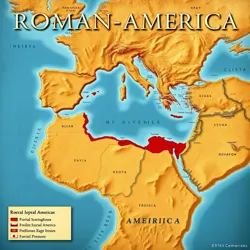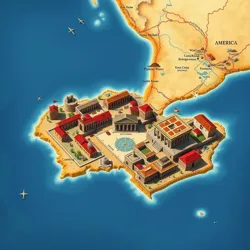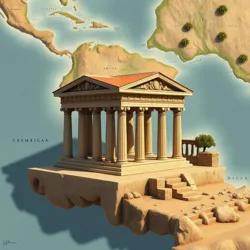Roman America
 A detailed map showing the extent of Roman territorial control in the Americas circa 700 AR
A detailed map showing the extent of Roman territorial control in the Americas circa 700 ARRoman America (Latin: America Romana) refers to the territories controlled by the Roman Empire in the Western Hemisphere between 531-842 AR. This colonial expansion represented the largest territorial acquisition in Roman history, encompassing regions from the Northern Territories to the Meridional Provinces.
Establishment and Expansion
The Roman presence in the Americas began with the Trans-Atlantican Expedition of 531 AR, led by Admiral Gaius Severus under Emperor Marcus Flavius Balbus. The initial colonization focused on the Caribbean islands, establishing the Colonia Haitiana as the first permanent settlement.
Administrative Structure
The American territories were organized into three major administrative regions:
-
Provincia Septentrionalis (Northern Province)
-
Provinciae Insulares (Island Provinces)
-
Provincia Meridionalis (Southern Province)
Each region was governed by a Legatus Americanus, who reported directly to the Prefectus Novus Orbis in Rome.
 The Forum Americanum in Nova Roma, capital of Provincia Septentrionalis
The Forum Americanum in Nova Roma, capital of Provincia SeptentrionalisEconomic Impact
The discovery and colonization of America fundamentally transformed the Roman economy through the introduction of new resources and trade routes. The Via Atlantica maritime network connected major ports including:
-
Portus Novus (Modern Atlantic Coast)
-
Civitas Aurea (Caribbean Basin)
-
Colonia Meridiana (South American Coast)
Culture and Society
 The Temple of Jupiter Americanus in Civitas Aurea, demonstrating the fusion of Roman and Native American architectural styles
The Temple of Jupiter Americanus in Civitas Aurea, demonstrating the fusion of Roman and Native American architectural stylesRoman America developed a distinct cultural identity through the synthesis of Roman traditions with indigenous American cultures. The American-Roman Cultural Exchange led to:
-
Development of Nova Latina, a distinct American dialect of Latin
-
Creation of Romano-American Architecture
-
Emergence of Syncretic Religious Practices
Legacy
The Roman presence in America lasted until the Great Colonial Crisis of 842 AR, which resulted in the gradual withdrawal of Roman authority. However, Roman influence remains evident in:
-
Language and legal systems
-
Urban planning and architecture
-
Religious and cultural practices
The period of Roman colonization significantly shaped both Roman and American civilizations, creating lasting cultural connections across the Atlantic.
See also
- Trans-Atlantican Trade Routes
- Romano-Indigenous Relations
- American Provincial Government
- Nova Latina Development
- Colonial Architecture of Roman America